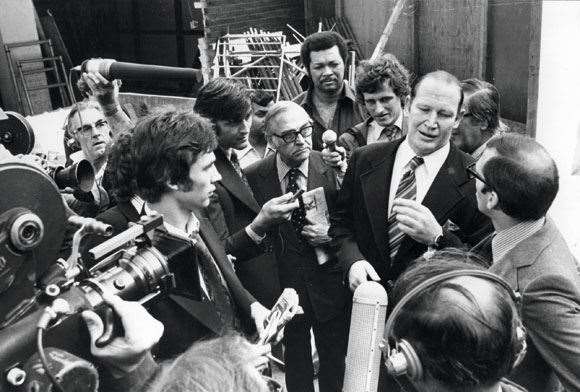Cricket became a true television sport in the ‘70s thanks to the – some say – brutish investment of billionaire Kerry Packer.
Cricket became a true television sport in the ‘70s thanks to the – some say – brutish investment of billionaire Kerry Packer.
 World Series Cricket driver Kerry Packer faces the media’s music in 1978.
World Series Cricket driver Kerry Packer faces the media’s music in 1978.Images: Getty Images
In 1976, Kerry Francis Bullmore Packer, billionaire owner of the Channel Nine network, heir, by default, to the family business after his more- favoured brother, Clyde, hightailed it to America, approached the Australian Cricket Board with an offer. He wanted to televise cricket, normally the province of the ABC, on Nine, starting the next summer. Perhaps it was his brutal, some say brutish, business approach that offended them (“There is a little bit of the whore in all of us, gentlemen. What is your price?”), but Packer’s offer was dismissed offhandedly, and the ABC was given a further three years.Furious and determined to get some cricket on his network, Packer directly approached the Test and County Cricket Board (TCCB) for the right to broadcast the upcoming Ashes series in England.His interest in a “breakaway” concept had already been piqued by a proposal put to him by businessmen John Cornell (“Strop” of The Paul Hogan Show fame) and player manager Austin Robertson to televise exhibition matches featuring cricket’s biggest names. He’d already secured in-principle support from a list of players supplied by Ian Chappell.That interest became a mission when he won his bid to telecast the Ashes from England, but only after he was forced to double it, thanks to a secret recommendation made by the Australian board to the TCCB not to accept his original price.
A rich and powerful man scorned is a dangerous being indeed. Kerry Packer wanted the right to broadcast Test cricket, and if he couldn’t have it, then he’d broadcast something even bigger and better. He’d saturate the game with cash and heap coals on the heads of his enemies. After all, what was Test cricket anyway, if its greatest characters were removed from it? He’d tried to be reasonable, and now he was going to rip its heart out.The game’s biggest names were already disgruntled at the amount they were paid for a job that monopolised their lives. With the help of Cornell, Robertson and England captain Tony Greig, Packer secured their signatures: Lloyd, Roberts, Holding, the Chappells, Marsh, Lillee and the immortals of South African cricket, Le Roux, Procter, Rice, Richards.
The Centenary Test in March of 1977 had been, fittingly, the last gasp of normality for Establishment cricket. Things would never be quite the same again. The whispers grew louder, and by the time the Aussies played that Ashes series in England, the signings had had a profound effect on morale; the Aussies lost the Ashes they’d spectacularly won three years earlier.The deed done, the pain over, the signed players couldn’t wait for the revolution to begin.
Packer surrounded himself with talent. Richie Benaud helped him negotiate rules and conditions for the new concept. Because Packer’s proposed tournament was barred from official venues, he poached ‘Gabba curator John Maley. Maley invented the drop-in pitch to deal with the problem of preparing instant decks at the leased venues of VFL Park, Football Park and Gloucester Park.
World Series Cricket, as it was now known, began on Channel Nine in November 1977 with a fanfare – a literal, musical fanfare. No one will forget the first urgent strains that heralded the revolution as they tuned in to Channel Nine. It’s an iconic sound still used by the station in Test promos. Then, of course, there was that earworm of a
jingle “Come on Aussie, Come on”.
The Establishment press derisively called it a circus. It was a magnificent circus, featuring the most formidable collection of players the world had seen, in titanic “Supertests” and one-day International Cup matches. Cricket under lights. Cricketers in colours. White balls. Cricket touring the provincial centres. The highest standards of cricket ever seen. Microphones out in the sacred middle. Cameras in the stumps. By its second year, once everyone got over their moral objections and the crowds increased, WSC innovations were widely accepted. Packer was allowed use of the SCG and the ‘Gabba.
With the help of visionaries like executive producer David Hill, Packer had succeeded in making cricket a true television sport. The telecasts were a phenomenon that impacted upon the broadcasting of sport across the world. The ABC’s telecasts of the conventional Tests looked stodgy in comparison. Fortunately for the Establishment, the revolution only lasted two years before rapprochement brought the rebels back into the fold. Kerry Packer had forever changed the way the world saw the sport he loved. Not bad for a bloke his father, the late Sir Frank, described as “the family idiot”.
– Robert Drane
Related Articles

Feature Story: Moving the Needle

The Aussies at The Open













